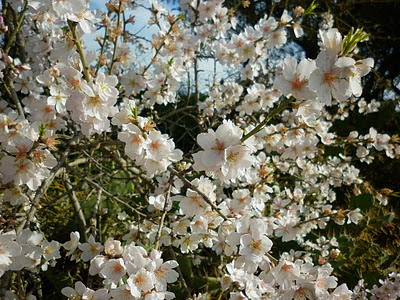
Wednesday, December 21, 2011
Wednesday, November 9, 2011
Mondego
A brilliant documentation (in English) about the Mondego-river in the centre of Portugal and its marvelous and unique wildlife.
Mondego from Daniel Pinheiro on Vimeo.
Thursday, October 27, 2011
Possible South Polar Skua?
This interesting Skua has been photographed during a pelagic trip I organized, on the 16-09-2011 off Fuseta/Algarve. My special thanks to Michael Southcott, who has joined this trip together with two friends, for sharing this and other pictures with me.

Large Skua Stercorarius sp about 5 miles off Fuseta (Algarve, Portugal) 16-09-2011. Photo: Michael Southcott (click photo to enlarge).
The uniformly whitish, "frosty" body, sharply contrasting to a very dark/blackish underwing, together with a relatively small, all brownish head, lacking the "cap" of an (adult) Great Skua Stercorarius skua, makes this a candidate for a South Polar Skua Stercorarius maccormicki (intermediate phase?) in my opinion.
The species is known to winter in the North Atlantic with regularity (pdf) and has been recorded in early September this year in Spanish waters (3 Ind. off Lanzarote and 1 Ind. at Estaca de Bares, Galicia, NW Spain) well documented on the blog of one of the observers here, as well as on Ricard Gutiérrez' website "Rare birds in Spain".
This is not the first "suspicious" Great Skua I am seeing here, but the first one that has been captured in a picture. I am not experienced with this species (I guess relatively few people are...) and lack certainty here, so I would be interested in any opinion on this matter. Field identification seems to be often difficult in this species and a different moulting cycle (reversed, being from southern hemisphere) and pattern (shorter moulting phase, replacing 3 primaries at once) in the species, often pointed out as a reliable criteria, is questioned to be that reliable here.
Is this bird still in the range of Great Skua Stercorarius skua ? Just a slightly aberrant "whitish" Individual ? But I never heard of a "pale morph" on Great Skua... Further, since no moulting is visible and together with the lack of the "cap" of an adult/subadult Great Skua, this has to be a bird before the first immature moult (takes place from December to February on Great Skua) = a fresh juvenile, in case it is "just" a Great Skua. But are not juvenile Great Skuas clearly rufus brown, with somewhat lighter "spots"? And finally, is it possible to identify this bird based on this photo at all ?
Large Skua Stercorarius sp about 5 miles off Fuseta (Algarve, Portugal) 16-09-2011. Photo: Michael Southcott (click photo to enlarge).
The uniformly whitish, "frosty" body, sharply contrasting to a very dark/blackish underwing, together with a relatively small, all brownish head, lacking the "cap" of an (adult) Great Skua Stercorarius skua, makes this a candidate for a South Polar Skua Stercorarius maccormicki (intermediate phase?) in my opinion.
The species is known to winter in the North Atlantic with regularity (pdf) and has been recorded in early September this year in Spanish waters (3 Ind. off Lanzarote and 1 Ind. at Estaca de Bares, Galicia, NW Spain) well documented on the blog of one of the observers here, as well as on Ricard Gutiérrez' website "Rare birds in Spain".
This is not the first "suspicious" Great Skua I am seeing here, but the first one that has been captured in a picture. I am not experienced with this species (I guess relatively few people are...) and lack certainty here, so I would be interested in any opinion on this matter. Field identification seems to be often difficult in this species and a different moulting cycle (reversed, being from southern hemisphere) and pattern (shorter moulting phase, replacing 3 primaries at once) in the species, often pointed out as a reliable criteria, is questioned to be that reliable here.
Is this bird still in the range of Great Skua Stercorarius skua ? Just a slightly aberrant "whitish" Individual ? But I never heard of a "pale morph" on Great Skua... Further, since no moulting is visible and together with the lack of the "cap" of an adult/subadult Great Skua, this has to be a bird before the first immature moult (takes place from December to February on Great Skua) = a fresh juvenile, in case it is "just" a Great Skua. But are not juvenile Great Skuas clearly rufus brown, with somewhat lighter "spots"? And finally, is it possible to identify this bird based on this photo at all ?
Saturday, September 24, 2011
Autumn birds
First of all, please note my previous blog-entry regarding the dates for the next pelagics scheduled. Further dates can be arranged, we just have to have minimum 4 participants for the trips off Fuseta and at least 6 people to go out with the catamaran from Portimão.
The last trips have been all good, particularly regarding Great Shearwater (Puffinus gravis) which are exceptionally numerous in Algarvian waters this season. The birds are very obliging and we have always had extended, close views (up to two or three meters most times!). Ideal conditions for photography. In two cases we had to shift the dates for the trips for 1 or 2 days, because of weather/sea conditions.
Summary (trip-lists) of the last tours:
Fr., 23rd of September 2011
3h's (c. 8.00 to 11.00 a.m.) off Fuseta (east Algarve), no chumming.
Great Shearwater (Puffinus gravis) 21 Ind.+
Cory's Shearwater (Calonectris d. borealis) c. 10 Ind.
Scopoli's Shearwater (Calonectris d. diomedia) 1 Ind.*
Sooty Shearwater (Puffinus griseus) 1 Ind.
European Storm-Petrel (Hydrobates pelagicus) 2 Ind.
Northern Gannet (Morus bassanus) c. 20 + 80 Ind.(distant)
Great Skua (Stercorarius skua) 5 Ind.
Audouin's Gull (Larus audouinii) 3 Ind. (2 ad., 1 2nd W.) dune island
Slender-billed Gull (Larus genei) 1 Ind. (ad. W) when entering Ria F.
Common Tern (Sterna hirundo) 3 Ind. (juveniles)
* good views of the underwing in direct comparison to C.d.borealis close by the boat, bird also appearing slightly slimmer and paler when seen from above. A possible second Ind. could not be confirmed.
Fr., 16th of September 2011
7 h's trip off Portimão (c. 7.30 - 14.30), chumming.
Great Shearwater (Puffinus gravis) c. 45 Ind.
Cory's Shearwater (Calonectris d. borealis) c. 40 Ind.
Balearic Shearwater (Puffinus mauretanicus) 1 Ind.
Wilson's Storm Petrel (Oceanites oceanicus) 26 Ind. close to boat
European Storm Petrel (Hydrobates pelagicus) c. 150 Ind.*
Northern Gannet (Morus bassanus) 50+ Ind.
Great Skua (Stercorarius skua) 6 Ind.
Common Tern (Sterna hirundo) 2 Ind. (ad.)
Sandwich Tern (Sterna sandvicensis) 2 Ind.
Common Dolphin (Delphinus delphis) 100 Ind.+, some next to boat
* Between 6 and 8 miles we found dense flocks of swimming Petrels, one of about 100 birds and one of about 50 birds when going out. On the way back we had one of about 70 birds. The bigger flock consisted solely of Europ. Storm Petrels apparently, the others of both species, but they did not allow us to come close. These are probably "day-roosts", because the birds are known to be feeding at night.
Monday, 12th of September 2011
3 h's off Fuseta, no chumming
Great Shearwater (Puffinus gravis) 9 Ind.
Cory's Shearwater (Calonectris d. borealis) c. 10 - 15 Ind.
Balearic Shearwater (Puffinus mauretanicus) 10 Ind.
Wilson's Storm Petrel (Oceanites oceanicus) 2 Ind.
European Storm-Petrel (Hydrobates pelagicus) c. 25 Ind.
Northern Gannet (Morus bassanus) c. 20 Ind.
Great Skua (Stercorarius skua) 1 Ind.
Audouin's Gull (Larus audouinii) 2 Ind.
Common Tern (Sterna hirundo) 1 Ind.
The last trips have been all good, particularly regarding Great Shearwater (Puffinus gravis) which are exceptionally numerous in Algarvian waters this season. The birds are very obliging and we have always had extended, close views (up to two or three meters most times!). Ideal conditions for photography. In two cases we had to shift the dates for the trips for 1 or 2 days, because of weather/sea conditions.
Summary (trip-lists) of the last tours:
Fr., 23rd of September 2011
3h's (c. 8.00 to 11.00 a.m.) off Fuseta (east Algarve), no chumming.
Great Shearwater (Puffinus gravis) 21 Ind.+
Cory's Shearwater (Calonectris d. borealis) c. 10 Ind.
Scopoli's Shearwater (Calonectris d. diomedia) 1 Ind.*
Sooty Shearwater (Puffinus griseus) 1 Ind.
European Storm-Petrel (Hydrobates pelagicus) 2 Ind.
Northern Gannet (Morus bassanus) c. 20 + 80 Ind.(distant)
Great Skua (Stercorarius skua) 5 Ind.
Audouin's Gull (Larus audouinii) 3 Ind. (2 ad., 1 2nd W.) dune island
Slender-billed Gull (Larus genei) 1 Ind. (ad. W) when entering Ria F.
Common Tern (Sterna hirundo) 3 Ind. (juveniles)
* good views of the underwing in direct comparison to C.d.borealis close by the boat, bird also appearing slightly slimmer and paler when seen from above. A possible second Ind. could not be confirmed.
Fr., 16th of September 2011
7 h's trip off Portimão (c. 7.30 - 14.30), chumming.
Great Shearwater (Puffinus gravis) c. 45 Ind.
Cory's Shearwater (Calonectris d. borealis) c. 40 Ind.
Balearic Shearwater (Puffinus mauretanicus) 1 Ind.
Wilson's Storm Petrel (Oceanites oceanicus) 26 Ind. close to boat
European Storm Petrel (Hydrobates pelagicus) c. 150 Ind.*
Northern Gannet (Morus bassanus) 50+ Ind.
Great Skua (Stercorarius skua) 6 Ind.
Common Tern (Sterna hirundo) 2 Ind. (ad.)
Sandwich Tern (Sterna sandvicensis) 2 Ind.
Common Dolphin (Delphinus delphis) 100 Ind.+, some next to boat
* Between 6 and 8 miles we found dense flocks of swimming Petrels, one of about 100 birds and one of about 50 birds when going out. On the way back we had one of about 70 birds. The bigger flock consisted solely of Europ. Storm Petrels apparently, the others of both species, but they did not allow us to come close. These are probably "day-roosts", because the birds are known to be feeding at night.
Monday, 12th of September 2011
3 h's off Fuseta, no chumming
Great Shearwater (Puffinus gravis) 9 Ind.
Cory's Shearwater (Calonectris d. borealis) c. 10 - 15 Ind.
Balearic Shearwater (Puffinus mauretanicus) 10 Ind.
Wilson's Storm Petrel (Oceanites oceanicus) 2 Ind.
European Storm-Petrel (Hydrobates pelagicus) c. 25 Ind.
Northern Gannet (Morus bassanus) c. 20 Ind.
Great Skua (Stercorarius skua) 1 Ind.
Audouin's Gull (Larus audouinii) 2 Ind.
Common Tern (Sterna hirundo) 1 Ind.
Monday, August 29, 2011
More Pelagic's scheduled !
Please find here the dates for the upcoming trips off Fuseta (with Passeios Ria Formosa) and Portimão (Ecoceanus). We received already bookings for each of these dates, but there are still vacancies for all of them.
Please make your reservation via e-mail to georg@birdwatching-algarve.com or mobile phone +351 936129716.
It would be good to have a phone contact of you, too and to know the period of your stay here, allowing me to inform you on short notice, in case a tour has to be shifted because of weather conditions or so.
Google-map to "Passeios Ria Formosa" in Fuseta here.
Google-map with directions to "Ecoceanus" in Portimão here.
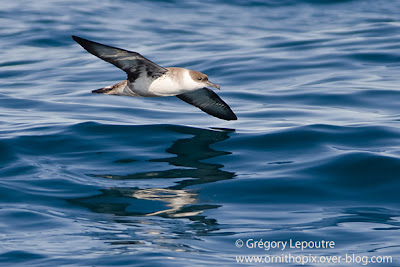
Great Shearwater (Puffinus gravis) about 9 miles off Portimão (14th of August 2011). The bird first circled around the vessel during the chumming-session, then landed about 3 or 4 m behind the boat, looked what is under water, like a diver a few times and then disappeared diving for a sinking Sardine for something like 10 seconds, using his wings under water. Great moment ! Thanks to Grégory Lepoutre for sharing the wonderful photo !
September 2011:
1st of September (Thursday) - Pelagic off Fuseta
8.00 to about 11.00 a.m.
Min. 4 / max. 10 people
Price: 40 € per Person (25 € preço especial para socios da SPEA)
6th of September (Tuesday) - Pelagic off Fuseta
8.00 to about 11.00 a.m.
Min. 4 / max. 10 people
Price: 40 € per Person
12th of September (Monday) - Pelagic off Fuseta
8.00 to about 11.00 a.m.
Min. 4 / max. 10 people
Price: 40 € per Person (25 € preço especial para socios da SPEA)
!!!!!!!!!!!!!!!!!!!!!!!!!!!!!!!!!!!!!!!!!!!!!!!!!!!!!!!!!!!!!
Friday, 16th of September (new date !) - extended Pelagic off Portimão
7.30 to about 14.30 (c. 7 hours) including at least 2 hours of chumming.
We will head out to a sea-canyon between 10 and 15 miles off shore.
Soft drinks and snack included. Toilet on board.
Min. 6 / max. 9 people
Price: 70 € per Person
!!!!!!!!!!!!!!!!!!!!!!!!!
21st of September (Wednesday) - Pelagic off Fuseta
8.00 to about 11.00 a.m.
Min. 4 / max. 10 people
Price: 40 € per Person
October 2011:
11th of October (Tuesday) - Pelagic off Fuseta
8.00 to about 11.00 a.m.
Min. 4 / max. 10 people
Price: 40 € per Person
14th of October (Friday) - Pelagic off Fuseta
8.00 to about 11.00 a.m.
Min. 4 / max. 10 people
Price: 40 € per Person (25 € preço especial para socios da SPEA)
30th of October (Sunday) - Pelagic off Fuseta
8.00 to about 11.00 a.m.
Min. 4 / max. 10 people
Price: 40 € per Person (25 € preço especial para socios da SPEA)
November 2011:
17th of November (Thursday) - Pelagic off Fuseta
8.00 to about 11.00 a.m.
Min. 4 / max. 10 people
Price: 40 € per Person (25 € preço especial para socios da SPEA)
For more info and trip-reports please visit my website or previous blog-entries. Thank you.
I include here the species-list of the latest trip done with Ecoceanus / Portimão from 14th of August 2011, including both, Sooty- and Great Shearwaters. A trip-report from September 2010 is here.
Puffinus gravis 2
Puffinus griseus 2
Puffinus mauretanicus c. 30
Calonectris diomedia c. 80 (borealis, +2 possible diomedia)
Oceanicus oceanites c. 25
Hydrobates pelagicus c. 5
Stercorarius skua 1
Larus audouinii 1 juv.
Sterna hirundo 1 juv.
Morus bassanus c. 30
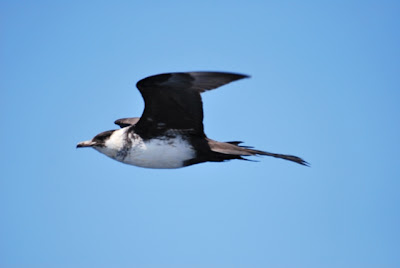
Adult pale-morph Pomarine Skua (Stercorarius pomarinus) off Portimão, 22-08-2011. Photo: Daniel Machados / Ecoceanus.
Wilson's Storm Petrel (Oceanites oceanicus) is one of the main target-species for Pelagic boat-tours in the Algarve. This has been subject to an article published in Dutch Birding recently.
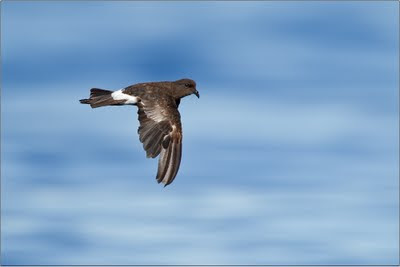
Wilson's Storm Petrels about 6 miles off Fuseta (east Algarve). July 2011. Both photos: Peter Schwarz. Many thanks for sharing !

Please make your reservation via e-mail to georg@birdwatching-algarve.com or mobile phone +351 936129716.
It would be good to have a phone contact of you, too and to know the period of your stay here, allowing me to inform you on short notice, in case a tour has to be shifted because of weather conditions or so.
Google-map to "Passeios Ria Formosa" in Fuseta here.
Google-map with directions to "Ecoceanus" in Portimão here.

Great Shearwater (Puffinus gravis) about 9 miles off Portimão (14th of August 2011). The bird first circled around the vessel during the chumming-session, then landed about 3 or 4 m behind the boat, looked what is under water, like a diver a few times and then disappeared diving for a sinking Sardine for something like 10 seconds, using his wings under water. Great moment ! Thanks to Grégory Lepoutre for sharing the wonderful photo !
September 2011:
1st of September (Thursday) - Pelagic off Fuseta
8.00 to about 11.00 a.m.
Min. 4 / max. 10 people
Price: 40 € per Person (25 € preço especial para socios da SPEA)
6th of September (Tuesday) - Pelagic off Fuseta
8.00 to about 11.00 a.m.
Min. 4 / max. 10 people
Price: 40 € per Person
12th of September (Monday) - Pelagic off Fuseta
8.00 to about 11.00 a.m.
Min. 4 / max. 10 people
Price: 40 € per Person (25 € preço especial para socios da SPEA)
!!!!!!!!!!!!!!!!!!!!!!!!!!!!!!!!!!!!!!!!!!!!!!!!!!!!!!!!!!!!!
Friday, 16th of September (new date !) - extended Pelagic off Portimão
7.30 to about 14.30 (c. 7 hours) including at least 2 hours of chumming.
We will head out to a sea-canyon between 10 and 15 miles off shore.
Soft drinks and snack included. Toilet on board.
Min. 6 / max. 9 people
Price: 70 € per Person
!!!!!!!!!!!!!!!!!!!!!!!!!
21st of September (Wednesday) - Pelagic off Fuseta
8.00 to about 11.00 a.m.
Min. 4 / max. 10 people
Price: 40 € per Person
October 2011:
11th of October (Tuesday) - Pelagic off Fuseta
8.00 to about 11.00 a.m.
Min. 4 / max. 10 people
Price: 40 € per Person
14th of October (Friday) - Pelagic off Fuseta
8.00 to about 11.00 a.m.
Min. 4 / max. 10 people
Price: 40 € per Person (25 € preço especial para socios da SPEA)
30th of October (Sunday) - Pelagic off Fuseta
8.00 to about 11.00 a.m.
Min. 4 / max. 10 people
Price: 40 € per Person (25 € preço especial para socios da SPEA)
November 2011:
17th of November (Thursday) - Pelagic off Fuseta
8.00 to about 11.00 a.m.
Min. 4 / max. 10 people
Price: 40 € per Person (25 € preço especial para socios da SPEA)
For more info and trip-reports please visit my website or previous blog-entries. Thank you.
I include here the species-list of the latest trip done with Ecoceanus / Portimão from 14th of August 2011, including both, Sooty- and Great Shearwaters. A trip-report from September 2010 is here.
Puffinus gravis 2
Puffinus griseus 2
Puffinus mauretanicus c. 30
Calonectris diomedia c. 80 (borealis, +2 possible diomedia)
Oceanicus oceanites c. 25
Hydrobates pelagicus c. 5
Stercorarius skua 1
Larus audouinii 1 juv.
Sterna hirundo 1 juv.
Morus bassanus c. 30
Adult pale-morph Pomarine Skua (Stercorarius pomarinus) off Portimão, 22-08-2011. Photo: Daniel Machados / Ecoceanus.
Wilson's Storm Petrel (Oceanites oceanicus) is one of the main target-species for Pelagic boat-tours in the Algarve. This has been subject to an article published in Dutch Birding recently.

Wilson's Storm Petrels about 6 miles off Fuseta (east Algarve). July 2011. Both photos: Peter Schwarz. Many thanks for sharing !

Tuesday, July 19, 2011
New dates for pelagic boat-trips !

Wilson's Storm Petrels off Portimão, Sept. 2010. Photo: Pim Wolf
The Algarvian waters now hold good numbers of Wilson's Storm Petrels (Oceanites oceanicus) and many other pelagic sea-birds, the first Sooty Shearwater (Puffinus griseus) of the season could also be observed already on the last trip, about eight days ago. Close observations under good conditions gave excellent opportunities for photographing this fascinating birds. For the moment, the following trips are scheduled and places are still available:
Tuesday, 26 of July 2011
A 3 hours-trip off Fuzeta with Passeios Ria Formosa
starting at 7.00 a.m., Price: 35 € p.p.
Further info
Trip-report
Further reports
SPECIAL RECOMMENDATION !!!
Sunday, 14th of August 2011
A 5-hours extended-trip off Portimão in the West-Algarve about 12 miles out to a sea-canyon, on the Catamaran of Ecoceanus
starting at 7.30 a.m., chumming, 6-9 people, Price: 55 € p.p.
Trip-Report
SPECIAL RECOMMENDATION !!!
Thursday, 1st of September 2011
A 3-hours trip off Fuzeta with Passeios Ria Formosa
Starting 9.00 a.m., Price is 35 € p.p. (25 € for members of SPEA)
Further info
Trip-reports
Tuesday, 6th of September 2011
A 3-hours trip off Fuzeta with Passeios Ria Formosa
Starting 9.00 a.m., Price is 35 € p.p.
Further info
Trip-reports
Monday, 12th of September 2011
A 3-hours trip off Fuzeta with Passeios Ria Formosa
Starting 9.00 a.m., Price is 35 € p.p. (25 € for members of SPEA)
Further info
Trip-reports
Please make your reservation via e-mail here, thank you !
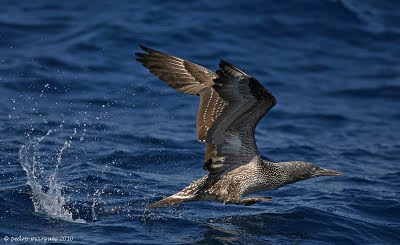
Juvenile Northern Gannet taking off next to the boat. Photo: Pedro Marques
Monday, July 11, 2011
Pelagic of today

Audouin's Gulls (Larus audouinii) where very obliging
Date: 11-07-2011
Time: 7.15 to 10.30 a.m.
Location: 6 miles off Fuzeta (East Algarve)
Conditions: Sunny, 18 to 25 C, hardly any wind (SW before), sea plain, low tide, no chumming.
Trip-list:
Cory's Shearwater (Calonectris diomedia borealis) c. 30 Ind.
Balearic Shearwater (Puffinus mauretanicus) 3 -4 Ind., close
Sooty Shearwater (Puffinus griseus) 1 Ind., good views
Wilson's Storm Petrel (Oceanites oceanicus) c. 25 Ind.
European Storm Petrel (Hydrobates pelagicus) None ! (unusual)
Northern Gannet (Morus bassanus) c. 20 Ind in total
Great Skua (Stercorarius skua) 4-5 Ind., all juv. or 2nd cy
Audouin's Gull (Larus audouinii) up to 4 Ind together
Sandwich Tern (Sterna sandvicensis) 1 Ind. (ad.)
Little Tern (Sterna albifrons) 1 Ind.
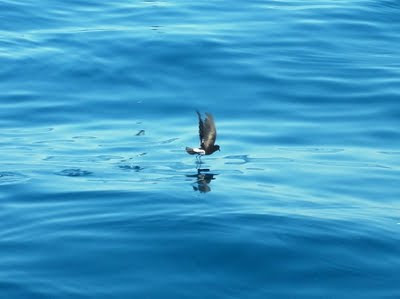
Wilson's ' showing a "light sheen" in the underwing, but never any white...

Sometimes can resemble Leach's Storm Petrel (slightly forked tail, pale band in the upperwing) but note that the silvery upperwing-band never reaches the carpal joint, the feet projecting the tail and (not visible) the obvious difference in size...
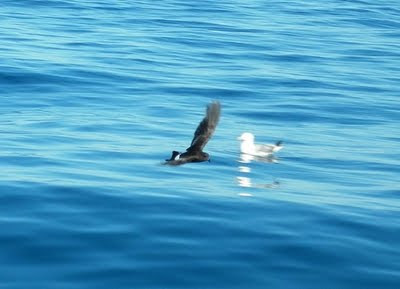
A very successful trip regarding Wilson's Storm Petrel, the main target, which we had around two trawlers mainly (3 or 4 birds at the first- and at least 16 Ind. together around the second fishing boat, when taking in the net). We watched them under ideal conditions and at very close distances (often less than 3 m !) when they were circling around the boats and also when foraging in the typical "Petrel-manner", touching the water with their yellow-webbed feet...
Most bird showed heavy primary-moult, the three outer primaries retaining. It was the first time I did not see any European Storm Petrel, when seeing good numbers of Wilson's-, no idea, why so.
On the way back we spotted splashing "Dolphins" but when we approached, they dived and we did not see any more of them. One participant saw a Flying fish.
A nice morning and good trip in the opinion of the participants. I am hoping for some good pictures, though I learned that photographing this quick and little "targets" at close distances is not an easy task and perhaps a 500mm lens is not the ideal tool to bring in this case. The record-shots I include here are made with a digital compact-camera (4x optical zoom) ;P ...
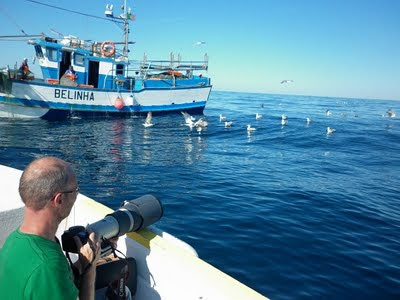
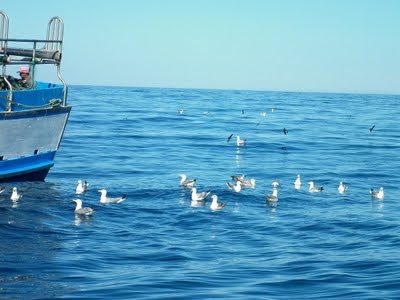

Great Skua (Stercorarius skua)
Monday, June 20, 2011
Pelagic Boat-Trips this summer
A series of Boat-trips has been scheduled, starting this next weekend. Pelagic birds are around...
11th July 2011 · 07:00 - 10:00
Location
Fuzeta, Algarve, Portugal
A Pelagic Boat-Trip off Fuzeta, East-Algarve, organized together with Passeios Ria Formosa. After crossing through the beautiful channels of Ria Formosa, we head out to the open sea (glass fiber motor boat for 12 people).
Target species: Wilson's Storm Petrel (Oceanites oceanicus), "European Storm Petrel" (Hydrobates pelagicus), Balearic Shearwater (Puffinus mauretanicus), Cory's Shearwater (Calonectris diomedea ssp.) and others... Most likely also Cetaceans, like the Common Dolphin (Delphinus delphis).
Price: 35 € p.p.
Reservation:
E-mail to
info@birdwatching-algarve.com or
passeios.ria.formosa@gmail.com
Or mobile to:
++351 962156922 (Ricardo Badalo) or
++351 936129716 (Georg Schreier)
Please be there about 10 Min. earlier.
Further, similar trips are scheduled for the 26th of July and the 14th of August 2011.
A summer-splash nature adventure !!!
More Info about the Tours here: www.birdwatching-algarve.com (including a map to the location).
Escape the summer heat on a cooling boat-trip and see some "cool" birds !!!

Cory's Shearwater (Calonectris (diomedea) borealis) off Fuzeta, Algarve, July 2010. Photo: Rasmus Nielsen.
Wednesday, May 18, 2011
(Eurasian) Black Vultures
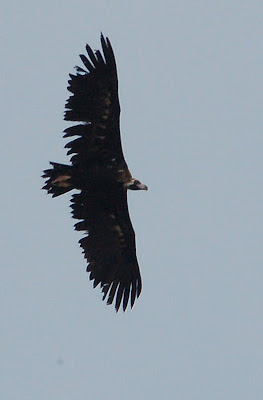
Eurasian Black Vulture (Aegypius monachus).
The pale head and bill-base and the advanced moult are indicating older immature / young adult. Baixo Alentejo, 29-04-2011. Photo: Craig Wright.
Among the impressive variety of raptors occurring in South Portugal, Eurasian Black Vulture (or: Cinerous Vulture) Aegypius monachus is one of the most impressive representatives. Normally seen accompanied by Griffon Vultures (Gyps fulvus) these "dark giants" scan the vast, steppe-like plain for carcasses. With a wingspan of up to 2,90 m, they are considered the biggest soaring birds in this part of the world. Their dark overall-appearance, lacking the strong contrast between black remiges and sandy-colored coverts, like in Griffon Vulture, soaring on flat wings and showing a "fingered, hanging hand", makes them unmistakable.

Eurasian Black Vulture (Aegypius monachus).
Baixo Alentejo, 29-04-2011. Photo: Craig Wright. The same Ind. as above. (Many thanks to Craig for sharing these photos!)
The majority of the European population nests in Spain (about 1100 pairs), mainly in the Extremadura, but there is a reintroduction-program running in the Alentejo, which has good chances to succeed, due to the positive population-trend in the Iberian Peninsula. Other than Griffons, they nest preferably in trees, solitary- or in loose colonies and are very sensitive regarding disturbances in the nest area. We observe Black Vultures from spring to autumn in the "steppes" of South Portugal - up to 6 different Individuals together during April and early May 2011. Most of them were young immatures. During autumn migration, the species is also seen in the Algarve, particularly the Sagres-Peninsula (October/November), when the big Vulture-flocks (up to 1000 or more Ind./day!) pass through the area on their way to Africa.
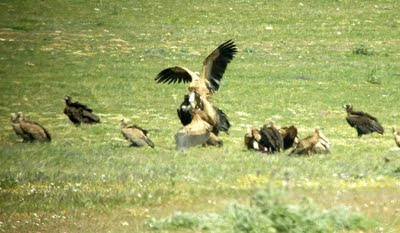
Griffon Vultures (Gyps vulvus) and Black Vultures (Aegypius monachus) feeding on a carcass. Alentejo, Portugal, 18-04-2011. Photo: GS.- digiscoped at a distance of around 200 m.
Monday, March 14, 2011
Lesser Kestrels and Great Spotted Cuckoos



A couple of Lesser Kestrel (Falco naumanni) sun bathing on their nesting box in the morning. Baixo Alentejo, 12-03-2011. Photo: GS.
At least 8 Great Spotted Cuckoos (Clamator glandarius) most times two birds chasing each other were among the highlights of a Day Tour last Saturday, together with brilliant views of Black-bellied Sandgrouse (more than 40 Ind. in a flock), Great Bustards (now start displaying) as well as both, Golden- and Spanish Imperial Eagles (immatures). What I never had so far, was a 2nd year Spanish Imperial Eagle (Aquila adalberti) circling about 40 to 50 m above us when we had pulled in on a small secondary road, slightly moved away, but then came straight back to us, calling two times (quite low pitched, surpressed and nasal) when flying over, looking down, really "checking us out" ! Amazing, the bird was not anxious at all, but curious ! Great views. I wish I have had the right camera equipment in this situation...
A sighting of these birds is never to guarantee, but recently I see them on most Tours into the area, and sometimes interacting ("tackling") with immature Golden Eagles. It seems they are coming back into these areas they belong to.
Around Faro today: Booted Eagle (6 Ind.) Wryneck, Woodchat Shrike, Little Bittern (male and female), Audouins Gull (3 adults) and Common Cuckoo. Spring is on the move. Expecting the first Bee-eaters and Collared Pratincoles back in the next 10 days...
Saturday, February 5, 2011
Rock Pipit

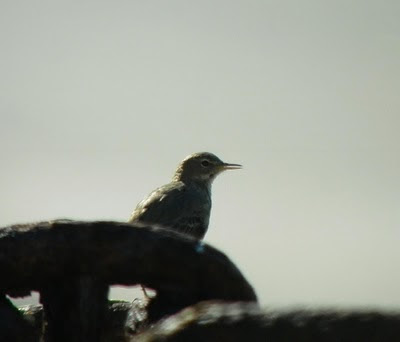
Rock Pipit (Anthus petrosus) in the harbor of Sagres today (05-Feb. 2011). A Rock Pipit (this one?) had been reported from this location some weeks ago. Not an easy one to distinguish from Water Pipit (A. spinoletta) in some cases. Both species were formerly seen together as the "Water Pipit-complex". This individual is rather untypical on the first look, a bird of the "Scandinavian" subspecies littoralis. Note the very long bill, the short supercillium, which does not continue behind the eye, dark-grey mantle and the dull underparts, which are diffuse and heavily streaked. I could not see the outer tail feathers. But most of all I found that the call was loud and sharp (accentuated) and sounded clearly different to the weaker and diffuser call of Water Pipit or anything I have ever heard from the latter species. An interesting article about the former "Water Pipit-complex" is here http://www.ntbc.org.uk/water and rock pipits.html - scroll down to the end of the page to see some similar Rock Pipits to this one here. Today, two Rock Pipits have been reported from Sagres harbor (and a Purple Sandpiper Calidris maritima, a species that I have found there with a Birdwatching-group this past December) - the photo I saw of the Rock Pipit today, showed a different, more typical Individual (all dull and dark). Yesterday, a Slavonian Grebe (Podiceps auritus) has been found and photographed in Ria Formosa just south of Faro, but I could not find the bird there this morning and it seems it has passed on. It is a species I have never seen in Portugal so far. There is also still a Goosander(Mergus merganser) present in the Alvor-estuary near Alvor. Just no Waxwings so far... :) but there has been a record in the 1960s in Portugal !
Saturday, January 22, 2011
Flowers
Tuesday, January 11, 2011
Digiscoping - experimenting new cameras

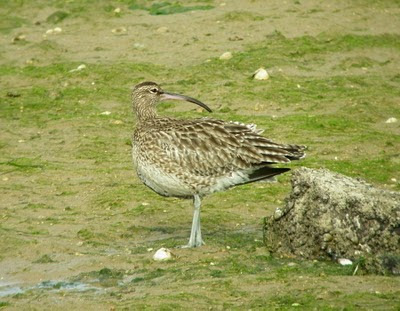
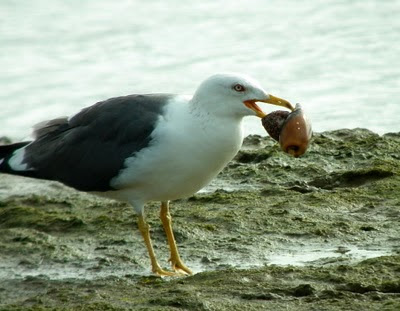
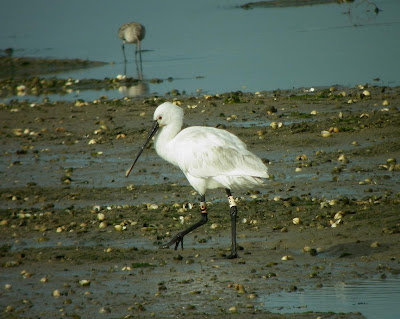
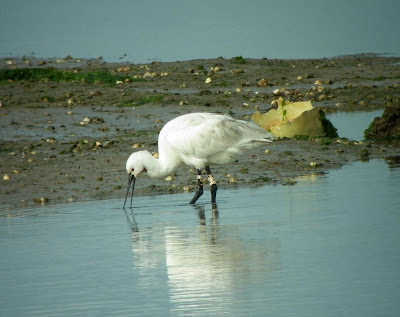
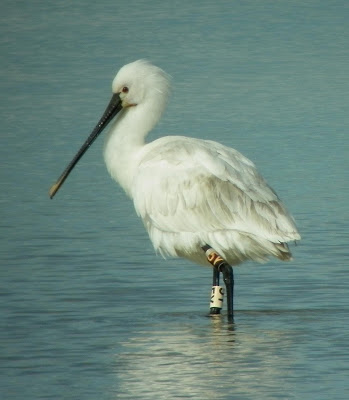
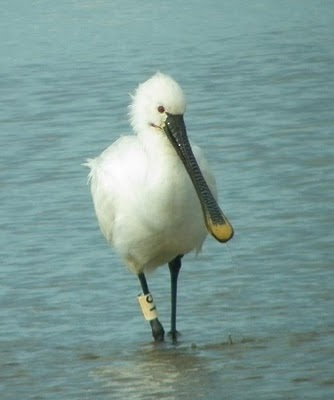
I am using the Leica Apo-Televid 77 Telescope since about 10 years now and I am still very happy with it. It is a great Telescope. For digiscoping, I used the Nikon Coolpix 995 and a handmade adapter so far which worked very well until finally now the camera has a defect. I was looking for something new anyway, since it had only a 3 Mega pixel sensor, it is a camera from the 1990s. The photo series above are made with a Panasonic Lumix DMC-F4 near Faro this morning - the photos are not bad, but also still not what I expect.... so I guess I have to keep on looking !
This color-ringed Eurasian Spoonbill (Platalea leucorodia) by the way is an almost 14 years old bird from the Netherlands (like a lot of Spoonbills we see here) and seems to winter since at least 10 years here in Ria Formosa. I have reported it already almost exactly 4 years ago from the same location. The life/history of the bird I received suggests also, that it migrates crossing through the Iberian Peninsula. If you ever see a color-ringed Spoonbill and can get the color-ring combination or the code, please send a photo or detailed description *including location, date, observer etc.) to o.overdijk[at]home.nl or visit this page (in Dutch) about the ringing program here: http://www.werkgroeplepelaar.nl/fotos.htm


These two digiscoping shots of a Booted Eagle (Aquila pennata) are made here some days ago with a Canon Powershot SX130 IS. The camera has a 12x optical zoom and 12 Megapixel (like the Lumix) but produces a horrible lot of vignetting when used at the telescope... no option, really...
All photos are processed with photo shop by the way (crop, sharpen, sometimes reducing noise, contrast, lightness etc. correction, but moderate... I usually avoid changing things like saturation or hue.
Thursday, January 6, 2011
Alentejo impressions

Baixo Alentejo, 2011-05-01. Photo: GS
Springtime here in South Portugal begins just after Christmas, is what I usually say and it is true. Serins (Serinus serinus) and Spotless Starlings (Sturnus unicolor) are singing outside, and the first Bees and Butterflies are visiting the flowering meadows. In the Alentejo, the vast inland open Oak woods and grasslands of South Portugal, Calandra Larks (Melanocorypha calandra) and Corn Buntings (Milaria calandra)are singing, while the fields are full of Golden Plovers (Pluvialis apricaria) and Lapwings (Vanellus vanellus) and Red Kites (Milvus milvus) are circling above the scenery, to name but a few common species.

The area is a great place to observe raptors. 2011-05-01. Photo: GS
Yesterday, observations of a Spanish Imperial Eagle (immature) close together with an adult Bonelli's Eagle, have been among the highlights of the trip. But also well a dozen Black-bellied Sandgrouse (Pterocles orientalis) in total gave good views. Spring has only begun, and the Alentejo will be full of flowers until around mid May. In the next weeks, the first migratory birds, like the Great Spotted Cuckoo (Clamator glandarius) will arrive here, while such elusive bird species as the Rufous Bush Robin (Cercotrichas galactotes), European Roller (Coracias garrulus) and White-rumped Swift (Apus caffer) will only come back from tropical Africa around mid April or even in May.

The Great Bustard (Otis tarda) is the emblematic bird of the Baixo Alentejo grasslands. Thanks to the successful conservation programs run by the Portuguese NGO "Liga para a proteçaõ da Natureza" (LPN) in the area, this magnificent birds and other "steppe" birds are increasing again but distribution is very local.
Some people call the area the Paradise in Portugal and it is a fantastic place for birdwatching without any doubt, recently ranked on 37 of the best Birdwatching destinations worldwide by the American Birding Association (ABA) here: http://blog.aba.org/2010/12/2010-top-40-the-birding-year-in-review-part-1.html#tp I met the author, Ted Floyd, on the Birdwatching Festival in Sagres in October 2009, when I was guiding a group of journalists and tour operators on behalf of the Algarve eco tourism company Sunquays. The event had been organized by the Tourism board of the Algarve.
Tuesday, January 4, 2011
2011 - Birds, birds, birds !
Wishing everybody a good year 2011 - healthy, happy, successful, prosperous and full of good birdwatching, of course !
Today has been an incredibly sunny day here around Faro, with temperatures close to 20 degree C and hardly any wind. The birds of prey liked it - Common Buzzards (Buteo buteo) performed display flights, "miauing" high above the Umbrella Pines and I counted a total of six Booted Eagles (Aquila pennata) in the area. Three Black-winged Kites (Elanus caeruleus) were also present.
In the afternoon, another Black-winged Kite was feeding on his catch on a telegraph post near Vilamoura, a couple of Marsh Harriers (Circus aeruginosus) was hunting nearby. Flocks of Spanish Sparrows (Passer hispaniolensis), lots of Corn Buntings (Milaria calandra) and a mixed flock of Lapwings (Vanellus vanellus) and Golden Plovers (Pluvialis apricaria) roosted on an acre.

Black-winged Kite (Elanus caeruleus) in Vilamoura today. Photo: Georg Schreier.
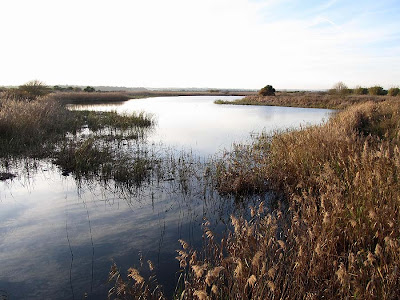
Extensive reed-beds in Parque Ambiental, Vilamoura. Photo: Georg Schreier
In the Marina of Quarteira, an adult Greater Black-backed Gull (Larus marinus) was easy to find, sitting on his favourite boat-Cabin again. I observed this bird there a month ago already, and probably the same Ind. the previous winter. An Irish Birder visiting the Algarve from time to time - we have been runing into each other already years ago, in Ludo, where he had just found a Baird's Sandpiper (Calidris bairdii), photographed another, ringed adult there recently. He also made a great capture of a flock of Common Scoter (Melanitta nigra) just before I arrived near the Marina with a Birding group, also seeing these birds.
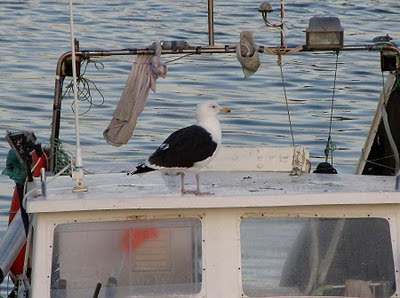
Adult Greater Black-backed Gull (Larus marinus) in Quarteira today. Photo: Georg Schreier.

Adult Greater Black-backed Gull (Larus marinus) with rings. Photo: Michael Davies.

Flock of 47 Common Scoter (Melanitta nigra), Quarteira, 2009-12-11. Photo: Michael Davies. There is just one adult male in the whole flock. Click on the picture to enlarge. Thank's Michael for sharing - a great shot, I really like it, it remembers me on one of the best observations during that afternoon !
Yesterday I observed an adult male Little Bittern (Ixobrychus minutus) close to the observatory at the São Lourenço Golf-Course, a Glossy Ibis (Plegadis falcinellus) was foraging close by, next to the ever present Azur-winged Magpies (Cyanopica cooki).
An apparently adult female Goosander (Mergus merganser) currently present at the Alvor-estuary (near Lagoa, west Algarve) is the first record of this species for the Algarve and not the only one in Portugal and Spain at the moment. Not a must for us being used to see these birds wintering further north but definitely a good Algarve tick.
Today has been an incredibly sunny day here around Faro, with temperatures close to 20 degree C and hardly any wind. The birds of prey liked it - Common Buzzards (Buteo buteo) performed display flights, "miauing" high above the Umbrella Pines and I counted a total of six Booted Eagles (Aquila pennata) in the area. Three Black-winged Kites (Elanus caeruleus) were also present.
In the afternoon, another Black-winged Kite was feeding on his catch on a telegraph post near Vilamoura, a couple of Marsh Harriers (Circus aeruginosus) was hunting nearby. Flocks of Spanish Sparrows (Passer hispaniolensis), lots of Corn Buntings (Milaria calandra) and a mixed flock of Lapwings (Vanellus vanellus) and Golden Plovers (Pluvialis apricaria) roosted on an acre.

Black-winged Kite (Elanus caeruleus) in Vilamoura today. Photo: Georg Schreier.

Extensive reed-beds in Parque Ambiental, Vilamoura. Photo: Georg Schreier
In the Marina of Quarteira, an adult Greater Black-backed Gull (Larus marinus) was easy to find, sitting on his favourite boat-Cabin again. I observed this bird there a month ago already, and probably the same Ind. the previous winter. An Irish Birder visiting the Algarve from time to time - we have been runing into each other already years ago, in Ludo, where he had just found a Baird's Sandpiper (Calidris bairdii), photographed another, ringed adult there recently. He also made a great capture of a flock of Common Scoter (Melanitta nigra) just before I arrived near the Marina with a Birding group, also seeing these birds.

Adult Greater Black-backed Gull (Larus marinus) in Quarteira today. Photo: Georg Schreier.
Adult Greater Black-backed Gull (Larus marinus) with rings. Photo: Michael Davies.
Flock of 47 Common Scoter (Melanitta nigra), Quarteira, 2009-12-11. Photo: Michael Davies. There is just one adult male in the whole flock. Click on the picture to enlarge. Thank's Michael for sharing - a great shot, I really like it, it remembers me on one of the best observations during that afternoon !
Yesterday I observed an adult male Little Bittern (Ixobrychus minutus) close to the observatory at the São Lourenço Golf-Course, a Glossy Ibis (Plegadis falcinellus) was foraging close by, next to the ever present Azur-winged Magpies (Cyanopica cooki).
An apparently adult female Goosander (Mergus merganser) currently present at the Alvor-estuary (near Lagoa, west Algarve) is the first record of this species for the Algarve and not the only one in Portugal and Spain at the moment. Not a must for us being used to see these birds wintering further north but definitely a good Algarve tick.
Subscribe to:
Posts (Atom)

